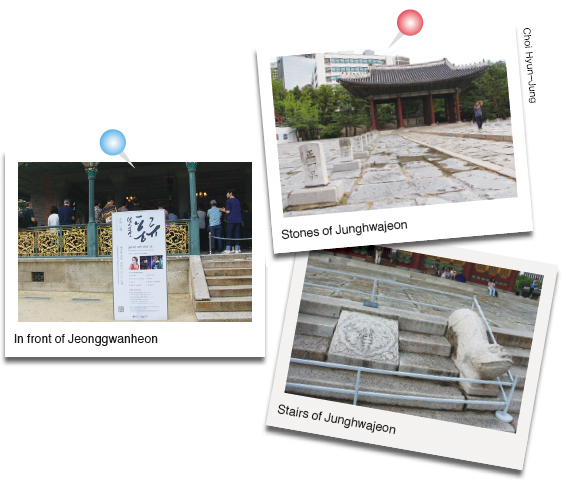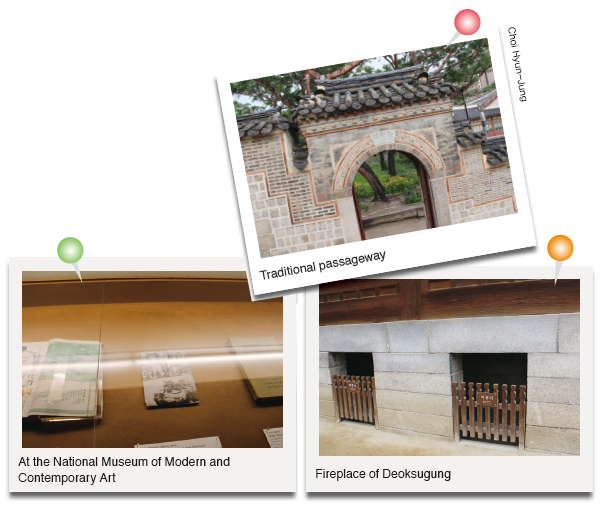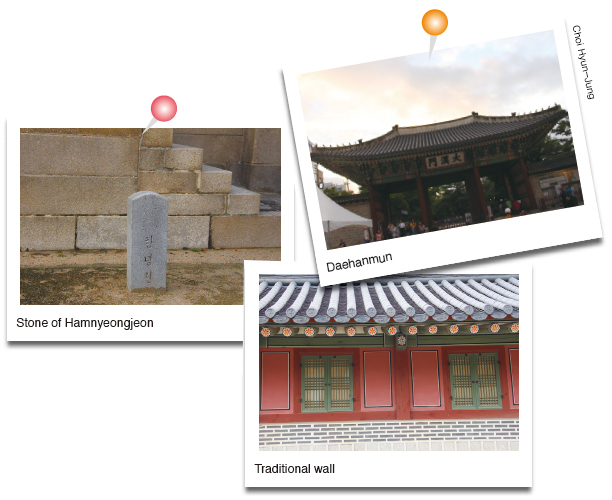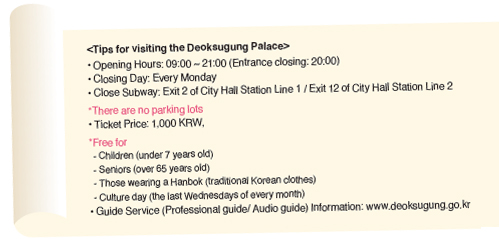This year marks the 100th anniversary of the Independence Movement Day and the establishment of the Provisional Government of Korea. Accordingly, The UOS Times visited Deoksugung Palace to celebrate the anniversary and to take a moment to reflect on the historical significance of the fight of our ancestors.

Deoksugung Palace is the place where King Gojong passed away, who is the 26th king and also the first emperor of Joseon. His death heightened the sense of national resistance of the nation as it was presumed that Japan poisoned King Gojong. The March 1 Independence Movement, was planned due to this heightened sense of national resistance. Although the original purpose of the March 1 Movement?the restoration of national independence and national sovereignty?was not achieved, but it still has meaning. It focused the world’s attention on the strong will of the Korean people for independence, thus laying the cornerstone for the establishment of the Provisional Government of Korea in Shanghai, China.
Consequently, the establishment of the Provisional Government’s 100th anniversary has a great significance. The Cultural Heritage Administration also considered this meaning deeply and specially established the Liberation Day celebration period (8.10-8.25) this year. During this period, Joseon’s royal palaces (Gyeongbokgung Palace, Changdeokgung Palace, Deoksugung Palace, and Changgyeonggung Palace), Royal Ancestral Shrine, and Royal Tombs were opened for free. Also, admission for the night view at Deoksugung Palace and Changgyeonggung Palace was free, so The UOS Times visited Deoksugung Palace at night to enjoy the view.

The UOS Times arrived at Deoksugung Palace just in time for the opening of the night entry. It was about 6’o clock so the sky was still bright. First, we saw the grand main entrance, Daehanmun. There were some people who were taking a rest or wandering at the gate. Since it opened for free to celebrate the National Liberation Day, we did not need to buy tickets. As soon as we entered the palace, we could feel fresh and big trees and the texture of the sand that we stepped on. Before we began our tour of the buildings, we read an explanation board about Deoksugung Palace. According to the explanation, Deoksugung Palace was the symbolic center of resistance in the face of several national crises, including the Japanese invasion and the difficulties during the closing years of the so-called Great Han Empire.
Buildings that we first met were Deokhongjeon Hall and Hamnyeongjeon Hall. These were very close to the entrance. There was a sign in front of every building here, so we also could see an explanation of the buildings. Deokhongjeon was the place that the king greeted high-ranking officials and foreign envoys and Hamnyeongjeon was the sleeping quarters of King Gojong. As you can see from the explanation, security must have been important for these buildings. Perhaps that’s why we could see the (high) walls surrounding the buildings only here. The other unique thing about Hamnyeongjeon was the interior. The outside of the building was built in a traditional structure; however the interior was decorated in the Western style with a chandelier. The structure felt strange but harmonious at the same time.
The sound of music from somewhere led us to the next building. The source of the sound was the Jeonggwanheon Hall. Jeonggwanheon is a place in the garden in the back of the palace for King Gojong’s resting time with coffee. He is famous as a coffee mania. The performance about patriotism and independence was being held there, and lots of people were watching it. This show required a separate ticket different from the admission ticket. We did not see this show closely, but we could feel the atmosphere enough. An interesting feature of this building was the verandas. The verandas were much larger than the indoor space and quite exotic, especially the color. Also, this hall was isolated on its own, and there was a lot of space around it with various flowers.

Walking along the road, we arrived at the next spot, Jeukjodang Area. Jeukjodang, Seogedang, and Junmyeongdang were all in this area. Jeukjodang is where King Gwanghaegun and King Injo were crowned, and Seogedang is where King Seonjo lived and passed away, so these buildings are particularly historic. Three buildings were very close together and some parts were connected. In this area, Seogedang was the most impressive because of its appearance. Unlike the other buildings, it was a traditional two-story building and had a natural rustic color such as brown, navy, and white. It was not grand or fancy, but we could feel another kind of traditional beauty here.
Then we moved with leisurely steps and soon we could see a magnificent building with a spacious front yard. It was Junghwajeon Area. It had been used as a temporary throne hall mainly for state ceremonies and formed the center of the palace. Uniquely, we could see stones that indicated where the officials stood according to rank during the assemblies. The stones reminded us of the scenes that we saw before in various traditional dramas or movies, so we felt like we were in a scene from the past. The scenery here was also impressive. On the back of the left side, there were Seokjojeon, which was built in the 19th century Western style and even further beyond, there were modern skyscrapers of the city of Seoul. Therefore, in front of Junghwajeon, we could see both the East and the West, the past and the present.
Of course, our next destination was Seokjojeon. On the way to Seokjojeon, there was a wide lawn which has a beautiful pond in the center. The view of the building blending with the greenery is still vivid to us. Seokjojeon was a representative Western style building of the Daehan Empire period. It consisted of various public spaces and private spaces for the imperial family. Now, it is used as Daehan Empire History Museum. You need to make a prior reservation via the homepage to see the 1st and 2nd floor of the building, but for the basement, reservation is not required. Right next to Seokjojeon, there was a National Museum of Modern and Contemporary Art, Deoksugung. The day we went, admission was also free for the same reason as Deoksugung admission. These two buildings are something that can never be seen in any other palace. Feeling the charm of the unusual buildings different from those of other Joseon palaces, our tour was concluded.
Overall, we were amazed by the fact that we could see the tall modern buildings from the palace. We were in the old palace, feeling the Joseon Dynasty, but we could also see the cityscape of the skyscrapers including the City Hall, which made us realize that we are in the 21st century. The past and the future coexisted with a wall between them. Another attractive point of Deoksugung Palace we recommend is Doldam-gil, which means stonewall walkway. In Korea, there is a myth if a pair of lovers walk Doldam-gil, they will break up. However, we could not believe it because the walkway was so beautiful. At nearly 7 o’clock, the lights were turned on which made it more beautiful. We took a lot of pictures on the way.

We would like to give you a little tip for visiting the palace; the closing day for Deoksugung Palace is every Monday. Also, be mindful of the opening hours so you are not pressed for time. Deoksugung Palace doesn’t have parking lots so if you are using the subway; use Exit 2 of City Hall Station Line 1 and Exit 12 of City Hall Station Line 2. There are many ways to get discounts on the ticket prices so please refer t o the explanation below. If you want a free professional guide service, visit www.deoksugung.go.kr and find time fit for you and language. The guide service is offered for Deoksugung Palace, Seokjojeon, and Jungmeongjeon too. You can also rent the audio guide, and it costs 3,000 KRW.
The most important thing that you should know before you go to the palace is to abide by the Cultural Properties Protection Law to protect Deoksugung Palace. You are not allowed to smoke and bring food and mats in the palace. Also, pets are not allowed inside. To also let others have an enjoyable time, please refrain from running and being noisy.
The UOS Times visited Deoksugung Palace and spent a day of rediscovering historical facts related to Deoksugung and honoring ethnic ancestors who sacrificed themselves for independence. If you see this article and visit Deoksugung Palace, you could have a chance to get out of the city, feel the relaxed atmosphere of the old palace, and relive the meaning of historical events such as the National Liberation Day with family and friends.
Choi Hyun-Jung
guswjd5891@uos.ac.kr
Kim Ji-young
zzero9999@uos.ac.kr
Kim Jin-woo
kjw1004i@uos.ac.kr
Yi Se-won
devel0ppe@uos.ac.kr

